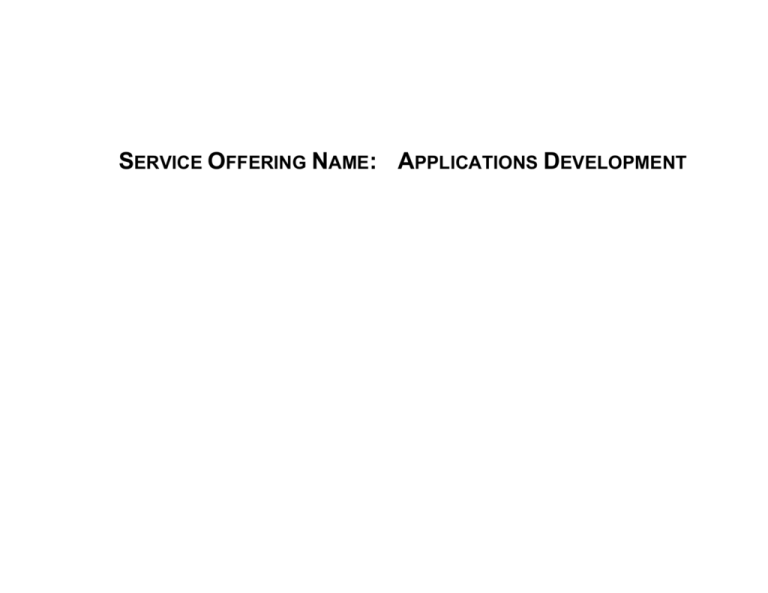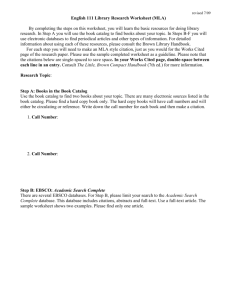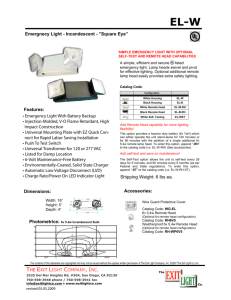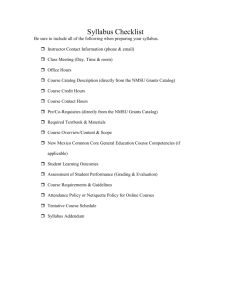
SERVICE OFFERING NAME: APPLICATIONS DEVELOPMENT
SERVICE OFFERING SPECIFICATIONS
PART ONE: SERVICE OFFERING OVERVIEW
The Service Offering Overview section provides a high-level, customer-centric answer to the question, “What is being offered by the IT
organization?” An effective description requires a thorough understanding of who the customer is, as well as a solid understanding of their specific
needs. It clearly articulates for the customer what they should expect regarding the services to be provided.
NAME:
Guide / Suggested Practices:
What is the outcome or reason for the service offering?
The service offering name is an integral component of its definition.
This is the top-level name which will appear in your catalog, and
should facilitate easy and quick browsing for your customers. For
this reason, the name should immediately convey the business
value and utility of the service in the language of your business
customers.
SHORT DESCRIPTION:
Guide / Suggested Practices:
What attributes of this service offering best describe and
distinguish it from other related service offerings?
The goal is to describe the service offering briefly, so that your
business customer can understand at a high level what this service
offering provides in comparison to other service offerings.
LONG DESCRIPTION:
Guide / Suggested Practices:
What attributes of this service offering are most meaningful to
your customer?
The goal is to describe the most relevant and meaningful attributes
of the service in the language of your business customers. Items
which the description might address are:
Features
Functions
Benefits
Scope of Service
What is not included
newScale® Service Offering Specification Worksheet
Page 1
© 2007 newScale, Inc. All Rights Reserved
PART TWO: SERVICE LEVEL DETAILS
The Service Level Details section provides a summary of the service level options available, and lays the foundation for effective measurement
and reporting. Too often service quality metrics are based on informal customer surveys or technical SLAs that are difficult to translate into
business value. A successful catalog must describe in business relevant language the level(s) of quality that IT can commit to deliver, together with
a list of choices the business customer may have regarding service level options and the impact of those choices on the overall price of the service
offering.
SERVICE LEVEL DESCRIPTION:
Guide / Suggested Practices:
What are the key service level commitments that IT is making
to the business customer regarding this service offering?
Briefly outline the key service level metrics and their targets. Later
in the service offering you will provide a detailed listing of each
service level objective and its specific performance metric.
Therefore, in this section you should endeavor to provide a highlevel summary description of service levels. Avoid detailed SLA
speak. Focus instead on those aspects of service quality that
matter most to your business customer.
SERVICE LEVEL OPTIONS:
Guide / Suggested Practices:
Are there service level choices that could reduce costs or
improve quality?
Service level options have a significant impact on the overall
quality-cost balance for a service offering. Most business customers
do not have the depth of understanding about IT services to
immediately or fully appreciate this particular facet of the costquality equation. This section should describe the various service
level options in terms which enable your business customer to
understand the specific decisions or actions which they can take to
directly impact the cost-quality balance to effectively address their
particular needs and objectives. This section should also detail the
impact of these decisions on the price and/or cost of service
delivery.
newScale® Service Offering Specification Worksheet
Page 2
© 2007 newScale, Inc. All Rights Reserved
Beyond an overview of available service level options, specific and measurable objectives should be defined. A successful catalog must provide a
means to monitor performance against clearly defined, relevant, and measurable objectives which are jointly established with business customers,
and which clearly articulate the business consequences of failing to meet these objectives. This enables IT to provide your business customers with
accurate and up-to-the-moment information on service quality, and further enables IT to communicate what it does, how well it does it, and the
business value that it represents to customers.
Name
Description
Unit of Measure
Target
Benchmark
Business Impact
Category:
Objective 1
Objective 2
Category:
Objective 3
Objective 4
newScale® Service Offering Specification Worksheet
Page 3
© 2007 newScale, Inc. All Rights Reserved
PART 3: PRICING
Without pricing and/or costing visibility, IT spending effectively represents a “black hole” for most Business Units. To effectively measure and
communicate IT business value, the catalog must provide financial transparency for your Business Unit customers, and link this information to key
financial business drivers. This enables you and your customer to track IT budgets and to forecast IT cost information against clear, concise
financial metrics. The addition of benchmarking data provides a more effective means to justify IT costs relative to industry averages.
Benchmarking helps you answer the customer’s question, “How can we tell if what we spend on IT is reasonable?” Pricing can be a derived from
detailed, bottoms up, activity based costing analysis, but it doesn’t need to be. More important than providing an analysis of all relevant IT costs is
the ability to provide a simple mechanism to the business to understand how changes to their operations, such as additional users or transactions,
will impact what they are charged for the service.
PRICE DESCRIPTION:
Guide / Suggested Practices:
What is the basis for pricing of this service offering?
The goal is to describe the most relevant and meaningful attributes
of the price of this service in units that are useful for your
customers’ planning and consumption management. The price or
cost should reflect real world measures your customers can control
to “dial up” or “dial down” expenses depending on business
conditions. Examples of measures include:
Employees
Contractors
Stores
Locations
Price drivers are the units that become the means of communication between the business and IT with respect to the planning and budgeting
conversation. As such, limiting the number of price drivers for a particular service to one or a few is often most effective. For each relevant price
driver the applicable unit price needs to be established and communicated. If desired a unit price multiplier can be defined that adjust the unit
price based upon selected service level objectives. A simplistic example of such a multiplier would be that the unit price is 25% higher for a Gold
service level.
Price Driver Name
Description
Unit Price
Benchmark Price
Service Level Multiplier
1
2
3
4
5
newScale® Service Offering Specification Worksheet
Page 4
© 2007 newScale, Inc. All Rights Reserved
PART FOUR: COMPONENT IT SERVICES
What are the standard service components that are included in this service offering? Service Components describe the details of an offering. For
example, a service offering for email may or may not include the component service of Blackberry Connectivity. Similarly, a service offering for
Application Hosting may or may not include the component service of Application Maintenance and Enhancements. An effective catalog provides
the customer with a consolidated and detailed view of business-relevant services which are included in the service offering – essentially, a detailed
bill of services. In addition, an effective service catalog details the various optional service components that can be included at an additional cost.
This enables IT to work closely with customers to manage costs and budgets at a detailed level, and effectively compare offerings against those of
managed service providers. Unit prices and quantities of included service components can be either predefined or established via formulas that
reference service level selections and or cost driver quantities
INCLUDED SERVICE COMPONENTS - OVERVIEW:
Guide / Suggested Practices:
Explain the scope of the service offering by specifying what is and is
not included. A service component should be specified if: (1) it has
a significant impact on the price of the service offering; (2) it is
something that is understandable to the business customer; and/or
(3) is important for purposes of comparison with external service
providers.
In addition, explain what optional service components can be added
to this service offering for an additional charge.
Service Component Details: Categorize and describe each included and optional service component. The Category field is used to group the
components in a logical set. In the Service Catalog they will appear in those groups. The most common categorization would be included services
and optional services.
Pricing of the service components may not be necessary, if their costs are covered by the overall service offering price drivers and unit prices. In
those cases the pricing field should read “included in the base price.” Where service components are optional or where additional amounts of
included service components are included, pricing should be established. Just as with service offering unit prices, the actual price can be modified
via a multiplier based upon selected service level objectives. If this is the case note the appropriate condition and calculation.
Quantity of included service components can be predefined. As an example, in the service offering Service Desk the number of emergency tickets
(a service component) can be derived from the number of Service Desk users (a price driver). If this is the case note the calculation.
Component Category Name:
1
Component Name
Overview
Service Level Description
Price Description (Calculation)
Included Qty. (Calculation)
newScale® Service Offering Specification Worksheet
Page 5
© 2007 newScale, Inc. All Rights Reserved
2
Component Name
Overview
Service Level Description
Price Description
Included Qty. (Calculation)
3
Component Name
Overview
Service Level Description
Price Description
Included Qty. (Calculation)
Component Category Name:
1
Component Name
Overview
Service Level Description
Price Description
Included Qty. (Calculation)
2
Component Name
Overview
Service Level Description
Price Description
Included Qty. (Calculation)
3
Component Name
Overview
Service Level Description
Price Description
Included Qty. (Calculation)
newScale® Service Offering Specification Worksheet
Page 6
© 2007 newScale, Inc. All Rights Reserved
PART FIVE: SERVICE MANAGEMENT DETAILS
Service Management details are those attributes of a service which a Service Level Manager may need to know but which is not necessarily
published to the business customer. These are details that need to be tracked regarding a service offering in order to deliver effectively.
ANTICIPATED CUSTOMER:
Guide / Suggested Practices:
Who are the main users of the service and where are they
located?
List of expected Customers (Core Business Units) that will require
the service, together with contact names and locations.
DELIVERY LOCATION:
Guide / Suggested Practices:
Where is the service available?
Specify if the service is restricted to certain locations, business units
and/or classes of employee.
SERVICE OWNER:
Guide / Suggested Practices:
Who is the Service Owner for this service?
Specify contact name and information.
SERVICE OFFERING CHANGE CONTROL:
E
How are changes to this service offering made?
Specify what IT and business roles are required to approve
changes to this service.
newScale® Service Offering Specification Worksheet
Page 7
© 2007 newScale, Inc. All Rights Reserved
PART SIX: PUBLICATION AND PRESENTATION
CATEGORIZATION and KEYWORDS: How and where is this Service Offering located in the catalog?
The point of a service catalog is to provide data to ITs business customers, to facilitate and enable conversations to rationalize and plan service
delivery in the context of the business priorities. An effective service catalog is made available to business customers on-line, leveraging familiar ecommerce metaphors. The service offering should be searchable by keywords and accessed via intuitive drill down categories, much like one
would navigate to an item on Amazon.com or any other commercial catalog. Delivering ease of use for business unit customers as they attempt to
access this information is an essential component in both the initial roll-out and the long term success of the service offering catalog. Customers
must be able to easily and quickly locate services and service information. Effective use of categories and subcategories ensures a positive
“shopping experience” for business unit customers, increasing the speed with which they will adopt the catalog.
Category – Level 1
Sub-Category – Level 2
Sub- Category – Level 3
Name
Description
Search
Keywords
newScale® Service Offering Specification Worksheet
Page 8
© 2007 newScale, Inc. All Rights Reserved





